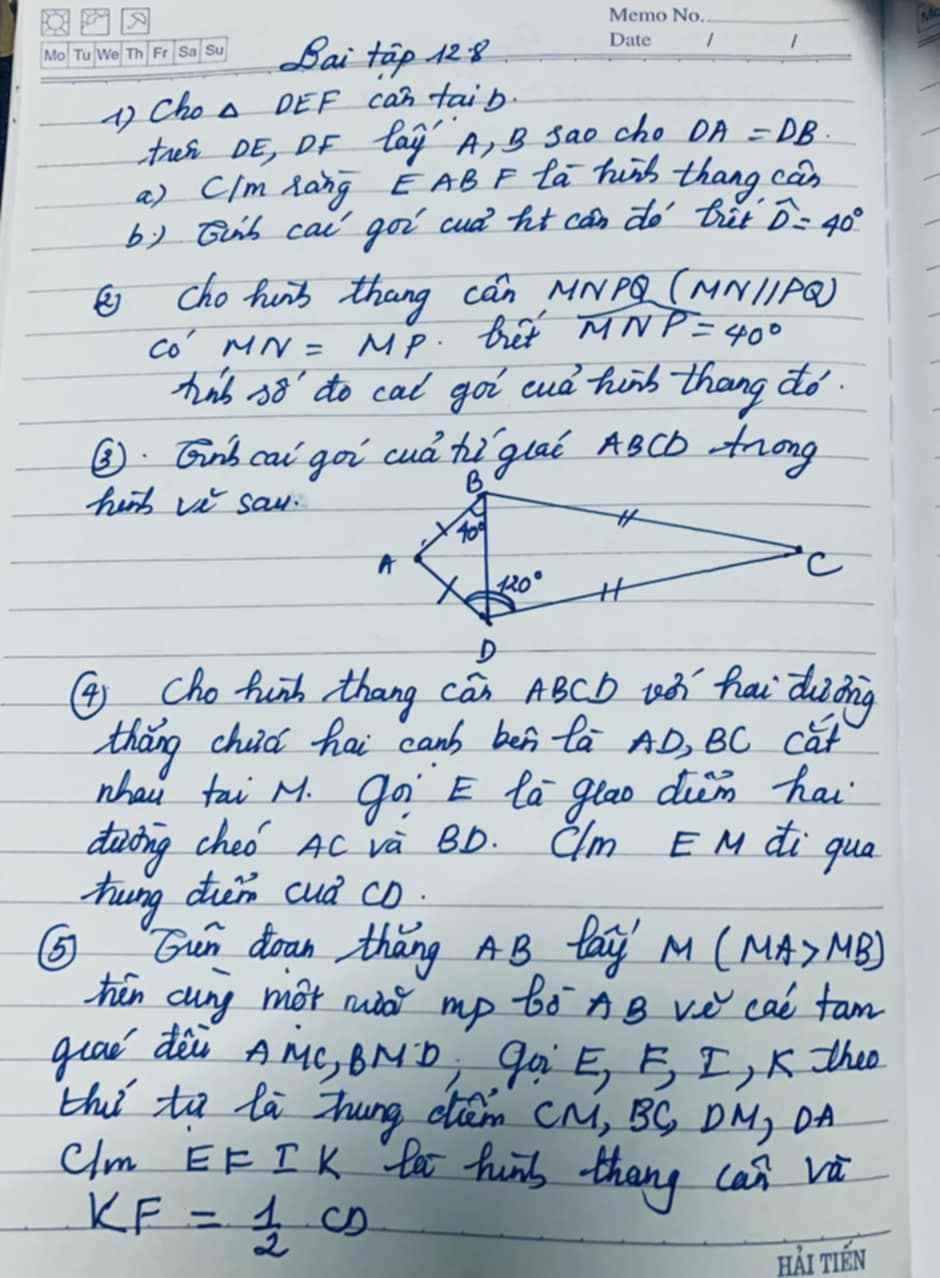phân tích thành nhân tử (x+y)^2-2(x+y)z+4z^2 gấpppppooo ạ
Hãy nhập câu hỏi của bạn vào đây, nếu là tài khoản VIP, bạn sẽ được ưu tiên trả lời.


a+b+c+d=0
=>c+d=-(a+b)
\(a^3+b^3+c^3+d^3\)
\(=\left(a+b\right)^3-3ab\left(a+b\right)+\left(c+d\right)^3-3cd\left(c+d\right)\)
\(=\left(a+b\right)^3-\left(a+b\right)^3-3ab\left(a+b\right)-3cd\left(c+d\right)\)
=-3ab(a+b)-3cd(c+d)
\(=3ab\left(c+d\right)-3cd\left(c+d\right)=3\left(c+d\right)\left(ab-cd\right)\)


\(\left(x+1\right)\left(x-1\right)-\left(x+1\right)\\ =x^2-1^2-x-1\\ =x^2-1-x-1\\ =x^2-x-2\)
Phân tích đa thức hay như nào em ơi?
A = (\(x\) + 1)(\(x-1\)) - (\(x+1\))
A = (\(x+1\))(\(x-1\) - 1)
A = (\(x+1\))(\(x\) - 2)

4: Xét ΔMDC có AB//DC
nên \(\dfrac{MA}{AD}=\dfrac{MB}{BC}\)
mà AD=BC
nên MA=MB
Xét ΔADC và ΔBCD có
AD=BC
CD chung
AC=BD
Do đó: ΔADC=ΔBCD
=>\(\widehat{ACD}=\widehat{BDC}\)
=>\(\widehat{EDC}=\widehat{ECD}\)
=>ED=EC
=>E nằm trên đường trung trực của DC(2)
Ta có: MA+AD=MD
MB+BC=MC
mà MA=MB và AD=BC
nên MC=MD
=>M nằm trên đường trung trực của CD(1)
Từ (1),(2) suy ra ME là đường trung trực của CD
=>ME đi qua trung điểm của CD
2: MNPQ là hình thang cân
=>\(\widehat{MNP}=\widehat{NMQ}\)
=>\(\widehat{QMN}=40^0\)
Ta có: MN//PQ
=>\(\widehat{MNP}+\widehat{NPQ}=180^0\)
=>\(\widehat{NPQ}=180^0-40^0=140^0\)
MNPQ là hình thang cân
=>\(\widehat{Q}=\widehat{NPQ}=140^0\)

a: Xét ΔABD và ΔACE có
AB=AC
\(\widehat{ABD}=\widehat{ACE}\)
BD=CE
Do đó: ΔABD=ΔACE
b: ΔABD=ΔACE
=>AD=AE: \(\widehat{BAD}=\widehat{CAE}\)
Xét ΔAHD vuông tại H và ΔAKE vuông tại K có
AD=AE
\(\widehat{HAD}=\widehat{KAE}\)
Do đó: ΔAHD=ΔAKE
=>HD=KE
c: ΔAHD=ΔAKE
=>AH=AK
Xét ΔABC có \(\dfrac{AH}{AB}=\dfrac{AK}{AC}\)
nên HK//BC

Sửa đề: EM=MA
Xét ΔMAB và ΔMEC có
MA=ME
\(\widehat{AMB}=\widehat{EMC}\)(hai góc đối đỉnh)
MB=MC
Do đó: ΔMAB=ΔMEC
=>\(\widehat{MAB}=\widehat{MEC}\)
mà hai góc này là hai góc ở vị trí so le trong
nên AB//EC

\(x^2-7x+2=x^2-2\cdot x\cdot\dfrac{7}{2}+\dfrac{49}{4}-\dfrac{41}{4}\)
\(=\left(x-\dfrac{7}{2}\right)^2-\dfrac{41}{4}>=-\dfrac{41}{4}\forall x\)
Dấu '=' xảy ra khi \(x-\dfrac{7}{2}=0\)
=>\(x=\dfrac{7}{2}\)
\(x^2-12x+5\)
\(=x^2-12x+36-31=\left(x-6\right)^2-31>=-31\forall x\)
Dấu '=' xảy ra khi x-6=0
=>x=6
`x^2 - 7x + 2`
`= x^2 - 2.x . 7/2 + (7/2)^2 - 41/4`
`= (x - 7/2)^2 - 41/4`
Do `(x - 7/2)^2 >= 0=> (x - 7/2)^2 - 41/4 >= - 41/4`
Dấu = xảy ra khi:
`x - 7/2 = 0`
`<=> x = 7/2`
Vậy ...
-----------------------
`x^2 - 12x + 5`
`= x^2 - 2.x.6 + 6^2 - 31`
`= (x-6)^2 - 31`
Do `(x-6)^2 >= 0 => (x-6)^2 - 31>= -31`
Dấu = có khi:
`x - 6 = 0`
`<=> x = 6`
Vậy .... (không có max )

\(1)A=x^2-7x+2\\ =\left(x^2-2\cdot x\cdot\dfrac{7}{2}+\dfrac{49}{4}\right)-\dfrac{41}{4}\\ =\left(x-\dfrac{7}{2}\right)^2-\dfrac{41}{4}\)
Ta có: `(x-7/2)^2>=0` với mọi x
`=>A=(x-7/2)^2-41/4>=-41/4` với mọi x
Dấu "=" xảy ra: `x-7/2=0<=>x=7/2`
\(2)B=9x^2-12x+5\\ =\left(9x^2-12x+4\right)+1\\ =\left[\left(3x\right)^2-2\cdot3x\cdot2+2^2\right]+1\\ =\left(3x-2\right)^2+1\)
Ta có: `(3x-2)^2>=0` với mọi x
`=>B=(3x-2)^2+1>=1` với mọi x
Dấu "=" xảy ra: `3x-2=0<=>x=2/3`

A = (\(x+y\))2 - 2.(\(x+y\))z + 4z2
A = (\(x+y\))2 - 2.(\(x+y\))z + (2z)2
A = (\(x+y\) - 2z)2
A = (\(x+y\) - 2z)(\(x+y\) - 2z)